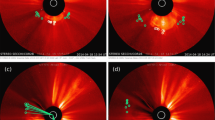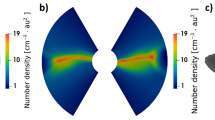Abstract
The Wang–Sheeley–Arge (WSA)–Enlil cone modeling system is used for making routine arrival-time forecasts of Earth-directed halo coronal mass ejections (CMEs), since they typically produce the most geoeffective events. A major objective of this work is to better understand the sensitivity of the WSA–Enlil modeling results to input model parameters and how these parameters contribute to the overall model uncertainty and performance. In this study, ensemble-modeling results for a succession of three halo CME events that occurred on 2 – 4 August 2011 are presented. We investigate the sensitivity of the modeled CME arrival times to small variations in the input-cone properties by creating ensemble sets of numerical simulations for each CME event, based on multiple sets of cone parameters. We find that the accuracy of the modeled CME arrival times not only depends on the small variations to the initial input geometry, but also on the reliable specification of the background solar wind, which is driven by the input maps of the photospheric magnetic field. The accuracy in the arrival-time predictions also depends on whether the cone parameters for all three CMEs are specified in a single WSA–Enlil simulation. The inclusion or exclusion of one or two of the preceding CMEs affects the solar-wind conditions through which the succeeding CME propagates. Although the accuracy of the modeled arrival times is sensitive to the input maps that are used to drive the background solar wind, the spread in the modeling ensemble remains mostly unchanged when different input maps are used.














Similar content being viewed by others
References
Arge, C.N., Pizzo, V.J.: 2000, Improvement in the prediction of solar wind conditions using near-real time solar magnetic field updates. J. Geophys. Res. 105, 10465.
Arge, C.N., Odstrcil, D., Pizzo, V.J., Mayer, L.R.: 2003, Improved method for specifying solar wind speed near the Sun. In: Velli, M., Bruno, R., Malara, F., Bucci, B. (eds.) Tenth Internat. Solar Wind Conf. CS-679, AIP, Melville, 190.
Arge, C.N., Luhmann, J.G., Odstrcil, D., Schrijver, C.J., Li, Y.: 2004, Stream structure and coronal sources of the solar wind during the May 12th, 1997 CME. J. Atmos. Solar-Terr. Phys. 66, 1295.
Arge, C.N., Henney, C.J., Koller, J., Compeau, C.R., Young, S., MacKenzie, D., Fay, A., Harvey, J.W.: 2010, Air force data assimilative photospheric flux transport (ADAPT) model. In: Maksimovic, M., Issautier, K., Meyer-Vernet, N., Moncuquet, M., Pantellini, F. (eds.) Twelfth Internat. Solar Wind Conf. CP-1216, AIP, Melville, 343. DOI .
Arge, C.N., Henney, C.J., Koller, J., Toussaint, W.A., Harvey, J.W., Young, S.: 2011, Improving data drivers for coronal and solar wind models. In: Pogorelov, N.V., Audit, E., Zank, G.P. (eds.) 5th Internat. Conf. Numerical Modeling of Space Plasma Flows, ASTRONUM-2010 444, Astron. Soc. Pac., San Francisco, 99.
Brueckner, G.E., Howard, R.A., Koomen, M.J., Korendyke, C.M., Michels, D.J., Moses, J.D., Socker, D.G., Dere, K.P., Lamy, P.L., Llebaria, A., Bout, M.V., Schwenn, R., Simnett, G.M., Bedford, D.K., Eyles, C.J.: 1995, The Large Angle Spectroscopic Coronagraph (LASCO). Solar Phys. 162, 357. ADS , DOI .
Burlaga, L.F., Plunkett, S.P., St. Cyr, O.C.: 2002, Successive CMEs and complex ejecta. J. Geophys. Res. 107(A10), 1266. DOI .
Davies, J.A., Harrison, R.A., Rouillard, A.P., Sheeley, N.R., Perry, C.H., Bewsher, D., Davis, C.J., Eyles, C.J., Crothers, S.R., Brown, D.S.: 2009, A synoptic view of solar transient evolution in the inner heliosphere using the heliospheric imagers on STEREO. Geophys. Res. Lett. 36, L02102. DOI .
Farrugia, C.J., Jordanova, V.K., Thomsen, M.F., Lu, G., Cowley, S.W.H., Ogilvie, K.W.: 2006, A two-ejecta event associated with a two-step geomagnetic storm. J. Geophys. Res. 111, A11104. DOI .
Gopalswamy, N., Yashiro, S., Michalek, G., Kaiser, M.L., Howard, R.A., Reames, D.V., Leske, R., von Rosenvinge, T.: 2002, Interacting coronal mass ejections and solar energetic particles. Astrophys. J. Lett. 572, L103.
Harvey, J.W., Hill, F., Hubbard, H.P., Kennedy, J.R., Leibacher, J.W., Pintar, J.A., Gilman, P.A., Noyes, R.W., Title, A.M., Toomre, J., et al.: 1996, The Global Oscillation Network Group (GONG) project. Science 272, 1284.
Henney, C.J., Toussaint, W.A., White, S.M., Arge, C.N.: 2012, Forecasting F10.7 with solar magnetic flux transport modeling. Space Weather 10, S02011. DOI .
Howard, R.A., Moses, J.D., Socker, D.G., Dere, K.P., Cook, J.W.: 2002, Sun Earth Connection Coronal and Heliospheric Investigation (SECCHI). Adv. Space Res. 29, 2017.
Kaiser, M.: 2005, The STEREO mission: An overview. Adv. Space Res. 36, 1483.
Lee, C.O., Arge, C.N., Odstrcil, D., Millward, G., Pizzo, V.: 2013a, Ensemble modeling of successive halo CMEs observed during 2 – 4 Aug 2011. In: Zank, G.P., Borovsky, J., Bruno, R., Cirtain, J., Cranmer, S., Elliot, H., Giacalone, J., Gonzalez, W., Li, G., Marsch, E., Moebius, E., Pogorelov, N., Spann, J., Verkhoglyadova, O. (eds.) Thirteenth Internat. Solar Wind Conf. CP-1539, AIP, Melville, 223. DOI .
Lee, C.O., Arge, C.N., Odstrcil, D., Millward, G., Pizzo, V., Quinn, J.M., Henney, C.J.: 2013b, Ensemble modeling of CME propagation. Solar Phys. 285, 349. DOI .
Liu, Y., Luhmann, J.G., Möstl, C., Martinez-Oliveros, J.C., Bale, S.D., Lin, R.P., Harrison, R.A., Temmer, M., Webb, D.F., Odstrcil, D.: 2012, Interactions between coronal mass ejections viewed in coordinated imaging and in situ observations. Astrophys. J. Lett. 746, L15.
Lugaz, N., Manchester, W.B. IV, Gombosi, T.I.: 2005, Numerical simulation of the interaction of two coronal mass ejections from the Sun to Earth. Astrophys. J. 634, 651.
Lugaz, N., Roussev, I.I., Vourlidas, A.: 2009, Large-scale structures caused by interacting coronal mass ejections: Their formation and detection as revealed by MHD simulations. Geophys. Res. Abstr. 11, EGU General Assembly 2009, Abstract 6510.
Lugaz, N., Vourlidas, A., Roussev, I.I.: 2009, Deriving the radial distances of wide coronal mass ejections from elongation measurements in the heliosphere – Application to CME-CME interaction. Ann. Geophys. 27, 3479.
Lugaz, N., Vourlidas, A., Roussev, I.I., Jacobs, C., Manchester, W.B. IV Cohen, O.: 2008, The brightness of density structures at large solar elongation angles: What is being observed by STEREO SECCHI? Astrophys. J. Lett. 684, L111.
Martinez-Oliveros, J.C., Raftery, C.L., Bain, H.M., Liu, Y., Krupar, V., Bale, S., Krucker, S.: 2012, The 2010 August 1 Type II burst: A cme–cme interaction and its radio and white-light manifestations. Astrophys. J. 748, 66.
Millward, G., Biesecker, D., Pizzo, V., de Koning, C.A.: 2013, An operational software tool for analysis of coronagraph images: Determining CME parameters for input into the WSA–Enlil heliospheric model. Space Weather 11, 57. DOI .
Möstl, C., Davies, J.A.: 2013, Speeds and arrival times of solar transients approximated by self-similar expanding circular fronts. Solar Phys. 285, 411. ADS , DOI .
Möstl, C., Farrugia, C.J., Kilpua, E.K.J., Jian, L.K., Liu, Y., Eastwood, J.P., Harrison, R.A., Webb, D.F., Temmer, M., Odstrcil, D., et al.: 2012, Multi-point shock and flux rope analysis of multiple interplanetary coronal mass ejections around 2010 August 1 in the inner heliosphere. Astrophys. J. 758. DOI .
Odstrcil, D.: 2003, Modeling 3D solar wind structure. Adv. Space Res. 32, 497.
Shen, F., Feng, X.S., Wang, Y., Wu, S.T., Song, W.B., Guo, J.P., Zhou, Y.F.: 2011, Three-dimensional MHD simulation of two coronal mass ejections’ propagation and interaction using a successive magnetized plasma blobs model. J. Geophys. Res. 116, A09103. DOI .
Temmer, M., Vrsnak, B., Rollett, T., Bein, B., de Koning, C.A., Liu, Y., Bosman, E., Davies, J.A., Möstl, C., Zic, T., Veronig, A.M., et al.: 2012, Characteristics of kinematics of a coronal mass ejection during the 2010 August 1 CME-CME interaction event. Astrophys. J. 749, 57.
Webb, D.F., Howard, T.A., Fry, C.D., Kuchar, T.A., Odstrcil, D., Jackson, B.V., Bisi, M.M., Harrison, R.A., Morrill, J.S., Howard, R.A., Johnston, J.C.: 2009, Study of CME propagation in the inner heliosphere: SOHO LASCO, SMEI, and STEREO HI observations of the January 2007 events. Solar Phys. 256, 239. ADS , DOI .
Xie, H., Ofman, L., Lawrence, G.: 2004, Cone model for halo CMEs: Application to space weather forecasting. J. Geophys. Res. 109, A03019. DOI .
Zhao, X.P., Plunkett, S.P., Liu, W.: 2002, Determination of geometrical and kinematical properties of halo coronal mass ejections using the cone model. J. Geophys. Res. 107, CiteID 1223, SSH 13-1. DOI .
Acknowledgements
The authors thank the California Institute of Technology, NASA Goddard Space Flight Center Space Physics Data Facility (SPDF), and National Space Science Data Center (NSSDC) for providing access to the ACE data set, the GONG program for providing access to their magnetogram data sets, and the agencies sponsoring these archives (NASA, NSF, USAF). The authors would like to acknowledge that SOHO is a project of international cooperation between the European Space Agency and NASA. In addition, the authors wish to express thanks to S. White, J.G. Luhmann, S. Lepri, and L. Mays for their informal discussions about multi-event signatures.
C. Lee thanks the referee for their assistance in evaluating and improving the content of this article.
This research was performed while C. Lee held a National Research Council Research Associateship Award at the Air Force Research Laboratory Space Vehicles Directorate in Kirtland Air Force Base, New Mexico. C. Lee was also supported by the Air Force Office of Scientific Research and the Institute for Scientific Research at Boston College.
N. Lugaz was supported by NASA grant number NNX15AB87G.
Author information
Authors and Affiliations
Corresponding author
Rights and permissions
About this article
Cite this article
Lee, C.O., Arge, C.N., Odstrcil, D. et al. Ensemble Modeling of Successive Halo CMEs: A Case Study. Sol Phys 290, 1207–1229 (2015). https://doi.org/10.1007/s11207-015-0667-2
Received:
Accepted:
Published:
Issue Date:
DOI: https://doi.org/10.1007/s11207-015-0667-2




